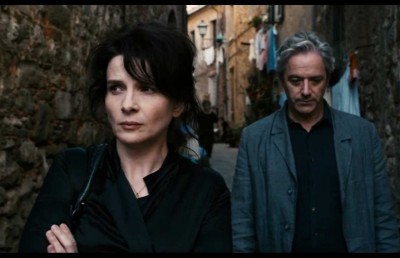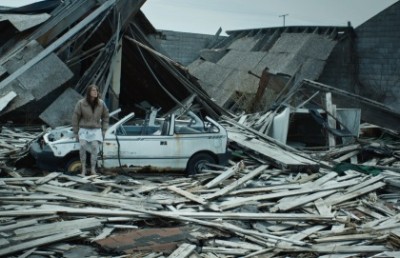In Search of the Details of a Lost Time: The Case of Kiarostami’s The Report
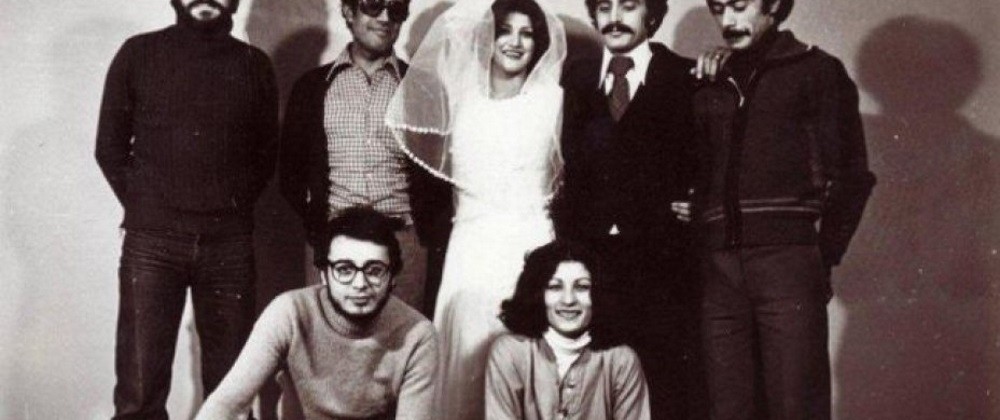
Almost a year has passed since the untimely death of the well-known Iranian director Abbas Kiarostami. Early this spring I caught myself contemplating writing a piece to commemorate his work and life. As I reviewed what I had written before 1 and also others’ research about Kiarostami’s vastly variegated body of work, I came to the rather shocking understanding that his very first feature film, Gozaresh (The Report, 1977), has been exempt from much critical review during the forty years that has passed since its initial release to wild acclaim. According to the Iranian film historian Jamal Omid (1995), Gozaresh had caught the attention of critics and film scholars in the sixth Tehran International Film Festival (yearly held before the Islamic Revolution) and also elicited very favorable reviews during and a little after its general release in late spring 1979 Tehran’s Cine Mond Cinema. Other than the reviews dating back to 1977, I could only find criticism of Gozaresh almost on the same page as the earlier reviews (mostly appreciative, and though rich in being attentive to certain aspects of the film, mostly lacking other details that had caught my attention while watching Gozaresh) 2 . As 2017 is also the 40th anniversary of the release of Gozaresh, I see this a very apt opportunity to focus on a movie in Kiarostami’s body of work which has not attracted much attention during these years compared to his other movies, video art, and photographs 3 .
In a short piece written as a sort of tribute to the memory of the late Kiarostami, Majid Eslami ponders: “Would the work of filmmakers like Farhadi in recent years seem outlandish if Kiarostami expanded his cinematic model on the basis of Gozaresh and his meticulous outlook in Gozaresh was allowed to manifest further?” This is a question worth deliberating. So, what also prompts me to see this movie as having been unfairly neglected in critical writing on the work of Kiarostami is the great impression it has supposedly had on some contemporary Iranian directors, namely the highly acclaimed Asghar Farhadi, and also its reminiscence in later films of Kiarostami himself 4 . The investigation of the parallels or, to be more precise, the complicated relationship between Gozaresh and contemporary Iranian films needs to be done after dealing with two different issues. One is understanding the place Gozaresh secures for itself in the Iranian cinema (both at the time of its very short release and after that 5 . The other is deliberating Gozaresh itself. In this essay, I will do my best to do the latter to some extent, though I am aware that the space of an essay does not allow me to go deep on all the details that I see as significant in Gozaresh. Having this in mind, I will be limiting myself mostly to the impact of Gozaresh on the viewer through its particular audio-visual form and also, most importantly, through the time-specific cultural picture it paints during its 109 minutes.
Gozaresh portrays the duration of almost a week in the life of a 30-ish civil servant named Mohammad Firouzkouhi. During this week he is accused of bribery (not actually taking bribes. Rather, he is accused of asking for it), and is also threatened of being evicted from the apartment in which he lives with his wife and little daughter. The week culminates in a great fight between him and his wife which leads to him beating her and her committing suicide by taking pills. He takes her to the hospital (where he is informed that she will survive) and sits by her side all night. In the morning, when she is about to become conscious, he simply leaves the room and then the hospital. The summary given does not show the nuances and subtleties in the narrative. I will investigate the complicated interplay of different forms and issues as I move forward.
In Gozaresh, Kiarostami concentrates on one example of the many young people who work in civil service. At work, Firouzkouhi has two rather close co-workers with whom he is on friendly terms. I refrain from calling them friends because through dialogues with his wife we are informed that the time he spends with them outside work (in casinos or in their apartments engaging in activities which are socially and morally unacceptable for married men) is mostly a means to maintain good relations with them (and with higher ranking officials) in order to have their support at work, rather than true friendship. At home, there is no to very superficial intimacy between him and his wife. They seem to just manage to live day to day doing what they are supposed to do. For Firouzkouhi this consists of going to work in the morning and coming back in the evening, spending the rest of the evening either at home, or going to casinos in place of friends or to their homes because he wants to look good at work, or if he feels no obligation to go to those places he might relent to his wife’s desire to go to a relative’s house for dinner (this never happens in the film and it should be noted that Azam’s desire for visiting the so-called relative is shown —through dialogue with his husband— to be based on a need to look good in their eyes and keeping their good relations with them). Here we as viewers become aware of both economical and traditional ties interlacing the lives of individuals who, as a result of being trapped in such ties, become incapable of making profound connections with each other.
So, in sheer contrast to some of more well-known movies of Kiarostami 6 , Gozaresh is not a celebration of life. Even in the depressing Taste of Cherry, which also deals with the consequences of the alienation its protagonist feels (becoming suicidal) and very minimally with the reasons of such alienation, there is some dialogue regarding the beauty and value of being alive. Gozaresh, quite conversely, seems to be grappling with the alienation and banality that ensues as a consequence of one’s general regard for one’s position in life. And here we, as viewers, or as the readers of The Report, are very objectively provided with what might be the reason of this alienation and passivity. According to what Kiarostami chooses to show us in Gozaresh, a very important contributor to this feeling of estrangement is one’s job. Another factor that feeds it is becoming stuck in one’s role with regard to one’s closest associations (In Gozaresh, as a husband or as a wife). A role that, in the case of Gozaresh, one has accepted mostly not through conscious and clear decision-making but through a mere want of doing what the majority of society does which for men is finding a job, securing a proper salary, getting married, having children. And for women is either the same or it is also acceptable that they don’t work outside and become housewives (this is the job they mostly fall into rather than consciously choosing it). The latter is the manner in which Azam, Firouzkouhi’s wife, has lived till this moment.
As one of the many situations in Gozaresh which guide our attention – either through images or dialogues (more generally, sounds) —to the tedium of a person’s job (I don’t differentiate between the monotony of house chores Azam is involved in on a day to day basis and the repetitious nature of Firouzkouhi’s work as a civil servant), the case of the title sequence of Gozaresh is worth scrutinizing. The movie starts with a shot of a white paper (on a typewriter) on which the opening credits of the movie gradually unfold during two and a quarter minutes. The names of the cast and crew are being typed as the paper constantly moves upward (out of the typewriter) and from left to right (since Farsi, the Persian language, is written from right to left) (Fig. 1). Alongside these visuals, there is the jarring sound of the typewriter as, apparently, someone is typing the credits who is not shown. Refraining to visually emphasize the human presence behind the typewriter during this opening sequence by choosing to focus on the result of the work being done sets the tone for the despondent narrative of the movie. Also, the prolonged viewing of the image (in which the result of typing develops) and simultaneously hearing the repetitive clacking sound (of the work of typing) is a very carefully chosen combination of sound and image to present the opening credits of Gozaresh as it registers a level of tedium and monotony on the viewer’s senses of vision and audition that prepares his/her imagination for what is to follow in the movie.
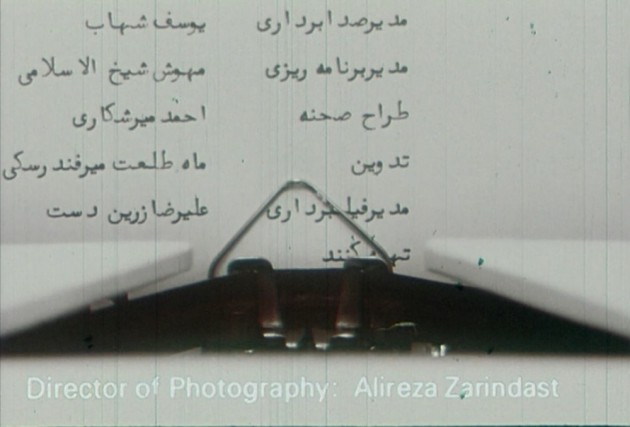
Fig. 1. The title sequence; inducing a sense of tedium right at the beginning of Gozaresh both visually and auditorily.
After being exposed during the title sequence to the sense of repetition and tedium both visually and auditorily 7 , we enter the space and duration of the movie.
As the narrative unfolds, the tedium of working in civil service and its consequences one of which is the frustrations of low income is shown in two different conversations between Firouzkouhi and Azam. The first 8 is around their impending eviction as a result of not being able to pay the rent of their apartment. This dialogue also lays the ground for demonstrating Firouzkouhi’s passivity by simply dismissing the problem of the impending eviction through snapping back in response to Azzam’s continuing worries that if they ever were evicted they could settle in Azam’s parents’ house. And when she answers that if she wanted to live there she would have not change her place of living, he says then they could settle in his own parents’ house. Despite the monotony of housework and taking care of their little daughter, Azam seems much more resolute in protecting the privacy and securing the autonomy of her little newly-shaped (at most 3-4 years old) family. This makes the alienation and passivity of Firouzkouhi even more pronounced. Whereas Firouzkouhi simply resorts to the most readily available solutions in this conversation and is not concerned with his independence from his parents (or his wife’s parents) as a married man, we once again see Azzam’s resolution for the improvement of their co-habited life in the second conversation 9 during which we hear Azam’s thoughts on buying their own apartment. Her hopes and plans for making this happen are met by minimal recognition on the part of Firouzkouhi. He even gently mocks her resort to God for working everything out and the practice of Nazr for such an occasion. Other than dealing with the estrangement of Firouzkouhi from his life, this conversation also brings to light the different world views of Firouzkouhi and Azam (an atheist and a semi-religious person as she doesn’t wear hijab outside) by talking of her belief in God and also a very common and popular religiously-rooted practice in the Persian culture called Nazr. It is simply asking God for something one wishes in exchange for vowing to do something oneself (donating money, visiting a religious place, doing charity work, etc.) 10 .
This adept utilization of dialogue for making known the very different world views common in the Iranian society (a society which still adheres to many of its traditions despite becoming modernized) and also making bold the popular religious beliefs deeply-rooted in the Persian culture is a great example of the objectivity of Kiarostami’s outlook and his intention to be totally loyal to reality in Gozaresh 11 As was described in the conversation between Firouzkouhi and his wife, this insistence in Gozaresh on showing what is real is demonstrated in how the vernacular language is used in each situation and by each person. The dialogues in the scenario are written in such a way to give a very realistic example of what is said in such a situation by such a person in everyday Iranian life at the time 12 . I will describe the details of another such situation. The client who accuses Firouzkouhi of taking bribes first talks to Mostafa (one of Firouzkouhi’s two friendly co-workers) before Firouzkouhi arrives at work. He announces his accusation of Firouzkouhi amidst a long monologue in which he swears on the life of his own children and also utters an aphorism which, he says, is a verse from the Holy Quran: “God’s curse be upon the one who bribes and the one who accepts the bribe.” 13 When Firouzkouhi arrives, a more or less physical conflict ensues at the beginning of which the man takes out a small volume of Quran from his coat’s pocket and insists that Firouzkouhi puts his hand on it and swear that he has not asked for bribe (Fig. 2). Here, Kiarostami’s adherence to reality is clearly shown in his incorporation of popular religious beliefs, aphorisms, and acts (rooted deep in Persian culture) in the scenario of a film which is targeted toward the intellectuals (and in a dialogue between a man from lower classes and the apparently atheist Firouzkouhi) 14 .
As I argued, doing this makes the situation and the interactions between the fictionalized people very down-to-earth and believable, especially for the Iranian viewer who knows the language. Another factor that has been cited as a source of the viewer’s sense of the realness while watching Gozaresh is that at its time it was the second movie in the cinema of Iran (after The Brick and The Mirror which was made twelve years earlier in 1965 by Ebrahim Golestan) which used the technology of recording the sound while filming the scenes, meaning the sound was not dubbed like all the other Iranian films in those years 15 .
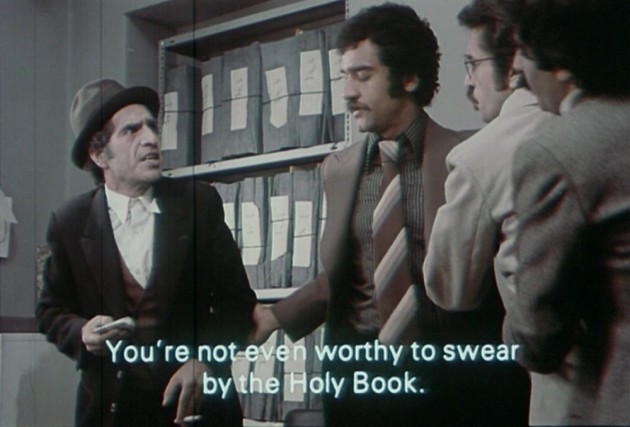
Fig. 2. Firouzkouhi snapping back at the client who, while holding a small volume of Quran in hand, insists that Firouzkouhi should swear on it
Gozaresh, as the meaning of its name aptly suggests both in Farsi and English (i.e. The Report), is not only a report of the bleak life of an Iranian civil servant at a particular period in history (contemporary time for the time of its filming and release) but also a report of Tehran at the very same period, namely that of winter 1977. During the course of the film we are privy to what happens at home to Firouzkouhi (and his wife and daughter). What goes on at his work in the governmental office is also generously shown to us. Yet, what the movie reveals does not finish with the ups and downs of what is happening in these two locations. Gozaresh unfolds in a measured way which provides the opportunity for different locations, professions, and recreations in Tehran, the capital of Iran, to be seen. Some examples are the street vendor right in front of Firouzkouhi’s office (shown from the point of view of his co-worker while talking on the phone by the window), the fruit seller from whom he buys a few pomegranates while Azam has gone to buy yarn for pullovers she is knitting for herself and her husband, the policemen who rebuke and guide Firouzkouhi, the workers painting a crosswalk (who are generously shown from different angles) (Fig. 3).
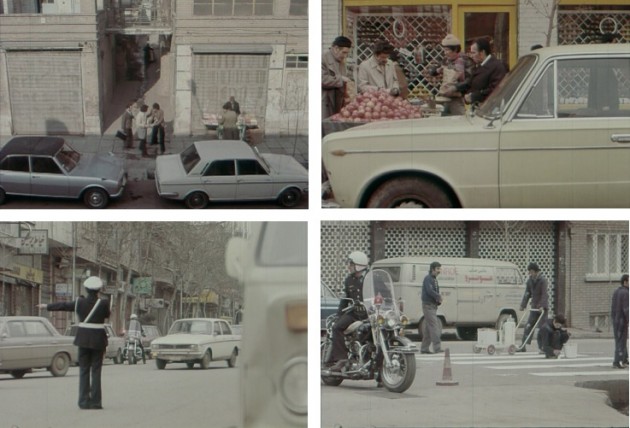
Fig. 3. The manifold professions seen on the streets of Tehran. Upper left: the street vendor in front of Firouzkouhi’s office, Upper right: the seller of pomegranates, Lower left: the policeman, Lower right: the workers painting a crosswalk
Kiarostami dedicates the time after two of the significant happenings in Gozaresh –one Firouzkouhi’s accusation of taking bribes, the other his beating his wife and leaving her at home alone – to showing two type of businesses in Tehran one of which (the casino) has been effaced completely since the revolution and the other (the bistro), while still existing, has been limited in the things it offers its customers. After leaving the office on his co-workers’ insistence with Mostafa’s car, Firouzkouhi goes to a casino and spends some time there. During the more-than-three-minutes sequence in the casino – during which nothing narrative-wise “happens” —we see the different single or collective acts of gambling and feel the care-free yet lonely atmosphere dominant in such a place at that time. Though no act specifically related to the narrative takes place, we get a sense of the feeling of boredom, passivity, and alienation that eats Firouzkouhi’s soul while having been given a realistic presentation of a casino in Tehran before the revolution (Fig. 4).
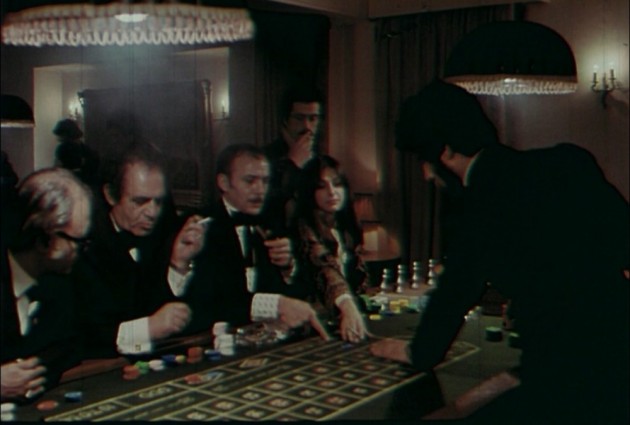
Fig. 4. In the casino
A sequence designed to serve as a great opportunity for hearing the opinion of different people in the Iranian society of the time takes place in a bistro operated by an Armenian middle-aged man. This is actually a very period-specific location because the colorful bottles of different brands of alcoholic drinks (mostly beer) is generously shown in the shots taken there (Fig. 5).
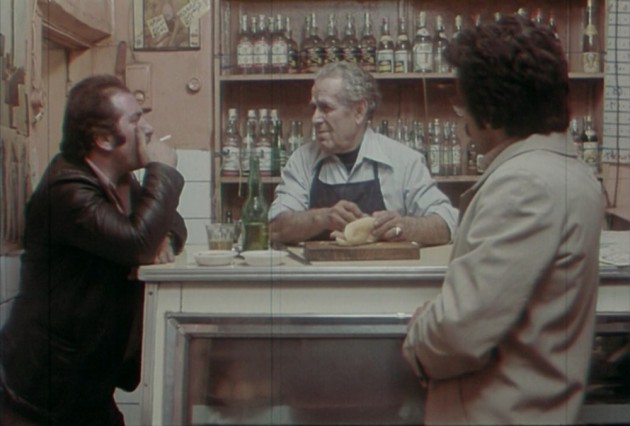
Fig. 5. In the bistro
After the Islamic Revolution the buying and selling of any kind alcoholic drink became illegal by the newly enforced Islamic law. It should be noted that, during the making of Gozaresh (or writing its scenario), Kiarostami could not have been thinking that he is realistically recording things and activities that are going to become illegal. Yet, being aware of what has happened in the country during the forty years since the making of this movie, as we watch Gozaresh today it gives a sense of being loyal to the historical specifications of the period in which it was made.
As I said earlier, Gozaresh is not a celebration of life. However, there is a sequence in which besides the bleakness and the dark presence of the notion of death – both as its real form, i.e. the talk about the death of a human being, and as its all-encompassing moment to moment happening in an alienated person (like Firouzkouhi)’s passive life which fills the gap from birth to death – we are offered a shred of hope by witnessing the sweet gesture of a stranger. I would like to conclude this piece by investigating the dialogue in this sequence, the beautiful unexpected gesture shown in it, and then its ending.
Almost one third into the movie, when Firouzkouhi is accused of taking bribes at work, he gets so enraged and irritated in confrontation with the accuser that Mostafa sends him away by lending him his car so that he calms down away from work. As he is seemingly driving with no particular aim, he picks up an unknown man on the road simply to help him get to his destination. As he is driving, the stranger reports that he is going to the hospital further on the road to visit his mother. Though Firouzkouhi shows minimal attention to what he says, the man goes on to explain that it’s been seven years since his mother is bedridden, and according to the doctors she should have died seven years ago. Yet, she is still breathing. “It is God who decides how long one must live” the man snaps, which is a famous aphorism in Farsi 16 . Continuing with his blabber, the man uses a quite well-known literary metaphor in Farsi in which a person’s lifetime is said to resemble pouring wine in a goblet the volume of which is determined by God in advance 17 . The man says: “Till her goblet is not brimming …” (his silence after this phrase means she continues to live). He resumes shortly: “It is in God’s hands. Her goblet must become brimming and then he’ll take her away. Maybe even we die while she is still living, depending on when her goblet becomes full.” Unfolding on a dull grayish background, this dialogue between the stranger as a believer in God (and as a result in fate) and the atheist Firouzkouhi again reveals the conflicting realities both present in the modernized Iranian society of its time through the befitting choice of the vernacular common language (spoken by both parties) yet different through the use of specific idioms that show the deeply-rooted cultural beliefs and traditions. Ultimately, the stranger reaches where he was headed. He asks Firouzkouhi to drop him off and tries to give him the fare. Firouzkouhi refuses to get any money and the stranger simply gets an orange out of the packet he was holding and puts it on the little space inside under the widescreen, above the steering wheel. Undramatized, tenuous, and fleeting, this slightly hopeful moment of offering what one has to show one’s appreciation is followed by the almost static long take (20 seconds approximately) of the stranger’s silhouette going towards a foreboding horizon before the cut to the sequence in the casino. Promptly, the bleak ambience of the narrative takes stage again.
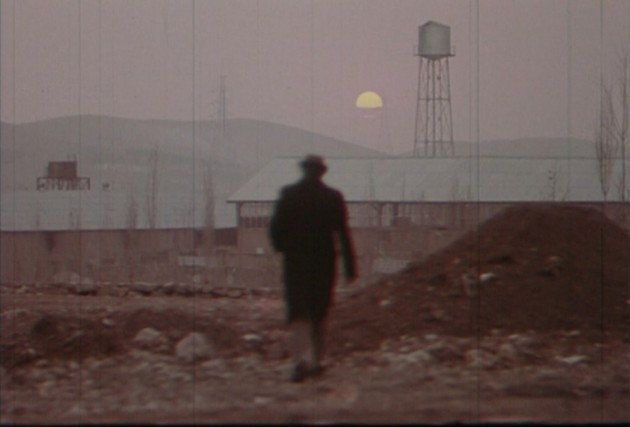
Fig. 6. The stranger going away
As I said at the beginning, Gozaresh is a movie that offers much to ponder over. There are still details worth paying attention to and trying to understand in their context. There are still points to make and issues to deal with and elaborate upon. Yet I prefer to withhold myself for now. This essay is mostly dedicated to discussing the details not deemed significant enough to discuss in earlier criticism (according to my own research about Gozaresh, which I hope has not neglected any previous research or criticism on this movie). I genuinely hope the details I attempted to make bold in this essay about such an important, yet neglected, movie pave the way for more profound thinking about Gozaresh, and also make locating its position in Kiarostami’s oeuvre and in Iranian cinema a little easier for interested scholars. This is my heart-felt tribute to the memory of the great Abbas Kiarostami.
Works Cited
Alberto Elena. “The Cinema of Abbas Kiarostami.”, translated into English by Belinda Coombes, SAQI books (in association with Iran Heritage Foundation), London, 2005 (Original edition: Abbas Kiarostami, Ediciones Câtedra, Madrid, 2002).
Majid Eslami. “Film-haayash az Takhayol-e Ma Ghavitar Bood: paasokh be chand soaal darbaare-ye Abbas Kiarostami” (His Films Were More Powerful Than Our Imagination: Answering a few questions about Abbas Kiarostami), in 24 (Hamshahri Cinema) magazine, issue 78, Mordad 1395 (August 2016), 50-51.
Jamal Omid. “Tarikh-e Cinema-ye Iran, 1279-1357” (The History of Iranian Cinema: 1900-1979) 1st edition, Rowzaneh Publishing Company, Tehran, 1374 (1995).
Hamid Naficy. “A Social History of Iranian Cinema,” Vol. 2: The Industrializing Years, 1941–1978, Duke University Press, 2011.
Mehrnaz Saeed-Vafa & Jonathan Rosenbaum. “Abbas Kiarostami” (The Contemporary Film Directors series), University of Illinois Press, 2003.
Bahman Maghsoudlou. Abbas Kiarostami: A Report, documentary, 88 minutes, 2013.
All photos are film stills from The Report (Gozaresh) (Abbas Kiarostami, 1977)
Feature photo taken from documentary Abbas Kiarostami: The Report (2013)
Notes
- My MA thesis (2015) was about the narrative construction in Kiarostami’s fictional feature films, the ones he made after the revolution of 1979 up to 2008 (the last one of which is Shirin), using the Bakhtinian concept of the chronotope ↩
- To get a sense of the paucity of criticism on Gozaresh, compared to Kiarostami’s other films refer to the great list composed by Alberto Elena at the end of his book (The Cinema of Abbas Kirstie) under the title “Studies on Abbas Kiarostami’s Films.” (With all due respect to Professor Elena, the correct page numbers of the review of Eric Fournier of Gozaresh in “Abbas Kiarostami: Textes, entretiens, filmographie complete” is 189-190.) Since 2005 (the publication of Elena’s book), I have encountered very few reviews or criticisms of Gozaresh, and the ones I have found are again mostly along the lines of the earlier critical feedback. It should be noted that what Bahman Maghsoudlou has tried to achieve might be considered an exception. In his documentary Abbas Kiarostami: A Report (2013), Maghsoudlou tries to locate the place of Gozaresh in Kiarostami’s career, in addition to discussing other movies by Kiarostami, by conducting interviews with Kiarostami and some of the cast and crew working with him during the making of Gozaresh, plus some prominent film critics and scholars. While this is warmly appreciated, as it at least provides some perspective, much more can be said and inferred critically about this great movie. ↩
- especially considering his final movie, 24 frames, completed and shown posthumously in Cannes 2017 ↩
- In his short piece commemorating Kiarostami, Majid Eslami has also dedicated the final paragraph (right after posing the thought-provoking question mentioned in the body of this essay) to his own opinion of the reasons why Kiarostami didn’t adhere to the cinematic model of Gozaresh, to the specific place of social cinema as a genre in Iran, and to the difference between the cinematic style of Farhadi and Kiarostami. This paragraph, though very short, seems a very good place to embark on an investigation of the place of Gozaresh among the social films made before and after it (and the few which were made at the same time as Gozaresh) and also its contribution to social cinema, i.e. socially-committed filmmaking, in Iran ↩
- Jamal Omid’s remarkable tome on the history of Iranian cinema (1995) provides the most minutely comprehensive historical account of the period yet it focuses very narrowly on the relationship between Gozaresh and the Iranian films made before and after it. I had the privilege of reading it in its original language, Farsi. Unfortunately its English translation is not available. For a brief English account of the making and release of Gozaresh with an eye on Omid’s writings, see the acclaimed work of Naficy (2011: 399-400) on the social history of Iranian cinema. Mehrnaz Saeed-Vafa also provides a rather short yet very interesting account of her own viewing of Gozaresh and also provides some historical context by mentioning the other films made around the same time and also in the years before and after that in English. See Saeed-Vafa and Rosenbaum (2003: 45-76) ↩
- especially in comparison to the Koker trilogy, i.e. Where Is the Friend’s Home? (1987), Life and Nothing More (1992), and Through the Olive Trees (1994)), and also The Wind Will Carry Us (1999). ↩
- I refrained from using the term “audiovisual” in order to more properly emphasize the role of sound in the beginning of the movie ↩
- seemingly on the same day of Firouzkouhi’s accusation at work ↩
- happening before their very-scarcely-shown attempt to make love at night, seemingly on the same day that Firouzkouhi is laid temporarily off from work ↩
- As an Iranian, I can attest to the diverse forms the practice of Nazr takes in the Persian culture. Though mostly religious, it is common even among the people who consider themselves atheists. They practice it by simply vowing to themselves that they will perform a specific action (which is mostly related to charity) if and only if what they want takes place. ↩
- Stated in Maghsoudlou’s documentary (in an interview) and also in a conversation with Iraj Saberi (in Cinema 6, issue 30, July & August 1978) quoted in Omid (1995: 740) ↩
- In Maghsoudlou’s documentary, Kiarostami has stated that as Gozaresh had been his first feature-length movie he was at the time very much concerned with the actors’ adhering to the scenario and he didn’t allow any improvisation in the dialogues while filming the scenes ↩
- This aphorism is not a verse of Quran. It is actually a hadith of the prophet Muhammad. ↩
- The details of another such exchange, happening after this sequence as Firouzkouhi drives away from work, is given near the end of this essay. ↩
- As this point is mentioned and dealt with in almost all reviews of Gozaresh, I am not going to discuss it further in my essay and prefer to call the attention of the reader to other neglected or less discussed points. See Omid (1995: 740-741). Also, in Bahman Maghsoudlou’s documentary Abbas Kiarostami: A Report (2013) the issue of the synchronized sound recording in Gozaresh is touched upon by Kiarostami and the sound designer of Gozaresh, the late Yousef Shahab ↩
- It should be noted that, while these aphorisms are openly religious and have a deep root in Persian culture, a large number of people (mostly intellectuals) do not believe in them any longer. Still, they are very widely believed in across the county among different social classes regardless of their economic situation. ↩
- It is the beauty of the Persian language that the Persian noun denoting this goblet (peymaaneh) also means size or capacity. ↩



